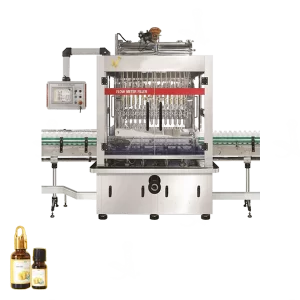Genuine automatic quantitative filling machine 2024
Note: Learn how to choose a high-quality filling machine to ensure your investment is in the right direction. Click on the image to see detailed instructions
Guide to buying a filling machine that suits your needs
The principle of quantitative filling is divided into two methods: quantitative by volume (liquid products) and quantitative by mass (powder, solid), that is Extract a certain volume or mass of product into a jar, bottle, jar, container...
-
- Volume dosing: Applying piston and servo dosing principles for liquid products with high low viscosity, even some products have high viscosity (chili sauce, honey, washing liquid).
- Dosing by volume: Applying cup and screw dosing principles and quantitative scales used mostly for the cosmetics and food industries (spices, milk powder, coffee).
Quantitative filling machines are widely used in the cosmetic and pharmaceutical industries, etc. Dosing by machine helps us improve hygiene conditions and ensure Always achieve high productivity and accurate product quantification.
Ensures high, stable productivity and meets HCCAP, GMP, ISO hygiene and safety standards. Depending on the filling materials, the equipment will have differences in the main working parts and filling structure.
Outstanding features of the machine
| The machine has a large capacity (2 - 24 extraction heads). |
| A variety of filling materials suitable for almost all solutions that need to be filled on the market. |
| Flexibility in disassembling parts for customization and integration in the line. |
| Equipped with fully automatic control features on the touch screen so productivity is very high and simple to use. |
| Fast filling speed, high accuracy. low error. |
| The main material is 304 stainless steel with high durability. The filling part in contact with the ingredients is made of 316 stainless steel. |
Common quantifiers
Valve-type quantitative filling machine
This is one of the simplest structures including: a graduated measuring tank, a three-way valve, a flexible vent tube, a connecting tube to fill the measuring tank, and a terminal. The same is the tube that pours the measured volume into the container.
The amount of liquid entering the measuring vessel depends on the position of the lower end of the catheter.
Measuring tank and slide valve type quantitative filling machine
At the bottom of the tank is installed a spring to keep the slide valve always in the lowest position. At that time, the mouth of the measuring flask is below the liquid surface of the container. When the slide valve is raised a certain distance, the measuring tank containing the liquid will be raised above the open surface in the tank.
At the same time, the holes on the slide valve and the bushing will coincide, allowing the liquid in the measuring tank to flow into the container. After the liquid has flowed out, the measuring jar is lowered, the liquid continues to flow into the measuring jar and the cycle will repeat. The liquid flowing into the packaging has a volume equal to the measuring jar. Therefore, when we need to change the quantity, we must change the measuring jar with the appropriate volume.
Isometric quantitative filling machine
Isometric mechanism is used to avoid losses when pouring liquid filled with CO2 gas.
The working cycle of this mechanism is: Fill the packaging with gas, the pressure of the gas and the gas-filled liquid is equal ➙ Open the liquid filling hole ➙ The liquid flows into the container without a pressure difference on the open surface but only flows thanks to the pressure head difference ➙ Fill to a predetermined level or over time (usually there is no dosing device) ➙ Close the liquid filling hole.
Open this in UX Builder to add and edit content




